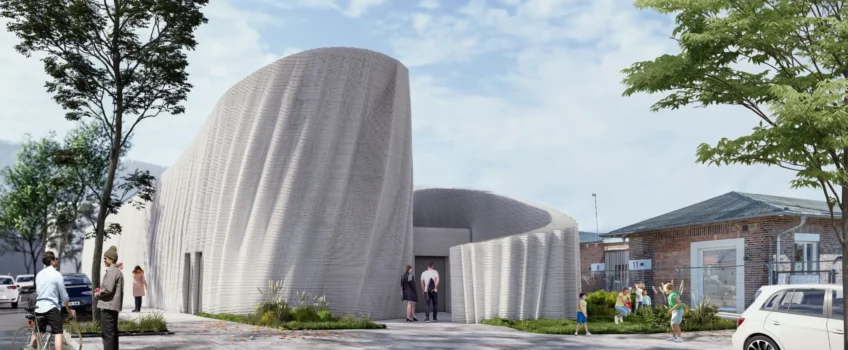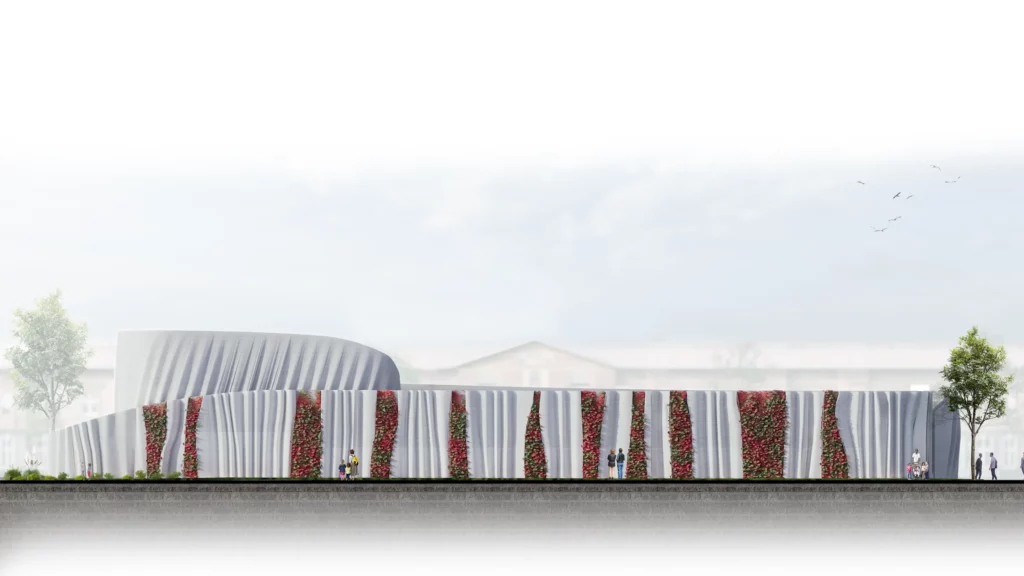
The next frontier in construction and architecture has been shaped by Copenhagen-based firm COBOD. They have unveiled an architectural marvel, setting a new milestone in the world of 3D printed structures. We present to you, an in-depth analysis of the project which is none other than Europe’s largest 3D printed building.
This collaboration includes Kraus Gruppe, Peri 3D Construction, SSV Architekten, Mense-Korte Ingenieure + Architekten, and DAW (Caparol, Alpina), under the direction of Heidelberg IT Management. The project is expected to be completed by July.
The Emergence of the 3D Printing Revolution
The 21st century has seen the dawn of 3D printing technology, revolutionising the way we approach manufacturing. From miniature models to large structures, 3D printing has presented limitless possibilities. In the construction domain, 3D printed buildings have emerged as a sustainable, efficient, and cost-effective alternative.
Beyond this current project, the architecture and construction industry has seen several remarkable 3D printed structures. From residential to military structures, and even large-scale manufacturing, the impact of 3D printing technology is profound and far-reaching. Below are 3 of our most popular blogs about 3D printing we think you should read:
- 3D Printing a House in One Day
- 3D Printed Military Barracks
- Large Scale Manufacturing and 3D Printing
The Genesis of COBOD
COBOD, an acronym for Construction Of Buildings On Demand, is an acclaimed pioneer in 3D printed construction. Their groundbreaking technology and innovative designs have made a significant contribution to the construction industry’s evolution. The company’s mastery in using robotics and 3D printing technology to construct buildings has made it a trendsetter in the field.
According to Kraus Gruppe, “the building will be recyclable and its 3D-printed construction will result in approximately 55% of the CO2 production compared to a standard Portland cement building.”
Henrik Lund-Nielsen, Founder and General Manager of COBOD said: “In this unique project Peri is emphasising two of the key benefits of 3D construction printing; speed of execution and design freedom . Because of this our technology is capable of carrying out everything from materials savings windmill towers over low cost residential housing in Africa to architectural office type buildings in Germany.”
A Glimpse into Europe’s Largest 3D Printed Building

The architectural masterpiece constructed by COBOD is a testament to the capabilities of 3D printing technology. Erected in Germany, the building, spanning 3,000 square meters, boasts an impressive three stories. The structure’s aesthetic appeal coupled with its robust construction has indeed redefined the standards of 3D printed architecture.
The construction of Europe’s largest 3D printed building involved meticulous planning and execution. The building design, constructed through the 3D printing process, led to the creation of an edifice that blends artistic expression and practical functionality.
The 3D Printed Data Centre will be 54 m (177 ft) long, 11 m (36 ft) wide and 9 m (29.5 ft) high, earning it the title of Europe’s biggest 3D-printed building, at least for now. Considering the rapid advancements in this sector, it remains to be seen how long it will hold this record.
3D Printing Process: The Method Behind the Marvel
The construction began with the creation of a digital blueprint. This detailed plan was then fed into a specialised 3D printer, which systematically laid down layers of concrete, following the design’s exact specifications. With careful monitoring and precision, the structure gradually took form, showcasing the remarkable capabilities of 3D printing in construction.
The 3D printed structure is not only an architectural triumph but it’s also functional. With open spaces promoting collaboration and private areas facilitating focused work, the building serves as an ideal working environment. The building’s artistic flair combined with its modern design aesthetics brings together a workplace that is as visually pleasing as it is efficient.
The construction process is similar to other 3D-printing projects where the printer dispenses layers of a concrete-like substance according to a pre-set blueprint which forms the fundamental structure of the building. The anticipated print duration is 140 hours and it will need two on-site construction workers to ensure a seamless execution. As mentioned earlier, the edifice is being erected with the COBOD BOD 2 printer, the same technology behind the 2020 3D-printed two-story house in Antwerp.
Sustainability: The Green Aspect of a 3D Printed Building
3D printed buildings are celebrated not only for their revolutionary construction methods, but also for their environmentally friendly impact. This innovative approach has several key features that enhance its contribution to sustainability.
At the top is its exact usage of materials. Unlike traditional construction methods, which often result in overuse or wastage of resources, 3D printing ensures that only the required amount of building material is used. This precision significantly reduces leftover materials and contributes to a more resource-efficient construction process.
3D printing also enhances the building’s energy efficiency by using intelligent design techniques and thermally efficient materials. As a result, a 3D printed building can retain heat better in winter while staying cool during the warmer months. This ability to regulate indoor temperatures reduces the need for artificial heating or cooling systems which can help saving on energy bills.
3D printed structures often incorporate cutting-edge technologies that further promote energy efficiency. From solar panels to rainwater harvesting systems, these sustainable features not only reduce the building’s carbon footprint but also help conserve natural resources.
The Future of 3D Printing in Construction
As COBOD’s architectural marvel stands tall, it represents not just an achievement, but a beacon of what the future holds. 3D printed buildings, with their efficiency, sustainability, and design flexibility, are paving the way for a new era in construction. Significant transformations are unfolding in this sector, and 3D printing is at the forefront. One certainty is that regardless of the sector you operate in, 3D printing will be a crucial component in various aspects of your business.
In conclusion, Europe’s largest 3D printed building by COBOD signifies a giant leap in architectural innovation. It stands as a testament to the immense potential of 3D printing in shaping our built environment, promising a future where construction is faster, greener, and more efficient.
For more interesting articles on emerging technologies, construction, fabrication, advanced manufacturing and precision engineering, visit our blog site.


 Mail:
Mail: 



